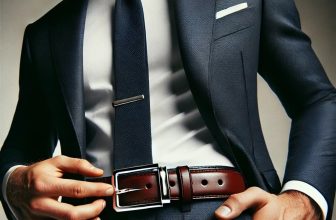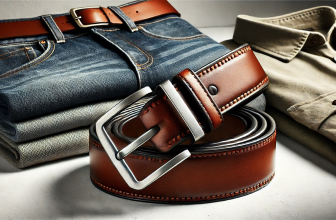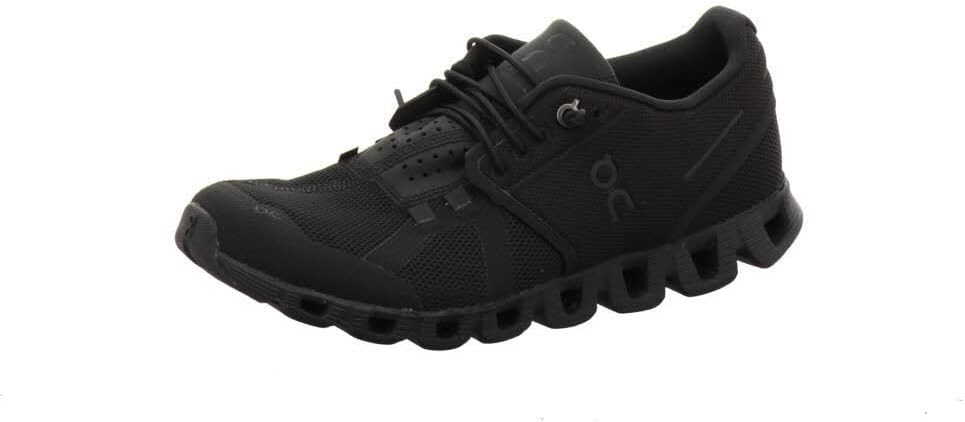Finding the perfect belt can feel like a frustrating challenge, especially when your waist size falls between two sizes. You’re not alone in this struggle; many men share the same dilemma, grappling with the discomfort of a belt that’s either too loose or too tight. The right fit is crucial not just for your comfort, but for projecting a polished style. In this blog post, we’ll delve into practical solutions and tips to help you navigate the nuances of choosing the ideal belt size, ensuring you look and feel your best, no matter your measurement.
Understanding Belt Sizes
Choosing the right belt size is essential for both comfort and style. This section will explore how men’s belt sizes are generally measured, how they differ from actual waist measurements, and why selecting the appropriate size is crucial for achieving an optimal fit and polished appearance.
How Belt Sizes Are Measured
Men’s belt sizes are usually determined based on the measurement of the waist. However, the sizing system can often appear confusing. Here are some key points to understand:
- Belt Length: Belt sizes are typically expressed in inches, which refers to the distance from the buckle prong to the middle hole of the belt.
- Belt Width: The standard width of men’s belts typically ranges between 1.25 to 1.5 inches. The width may vary depending on the style of the belt, such as formal or casual.
Common Belt Sizes and Measurements
| Belt Size | Waist Size (inches) | Example Brands/Models |
|---|---|---|
| 30 | 28-30 | Levi’s Casual Leather Belt |
| 32 | 30-32 | Dockers Men’s Casual Belt |
| 34 | 32-34 | Fossil Men’s Ingram Leather Belt |
| 36 | 34-36 | Timberland Men’s 35mm Casual Belt |
| 38 | 36-38 | Columbia Men’s Casual Leather Belt |
Note that while these are common sizes, actual measurements can vary between brands. It is always prudent to check the specific sizing guide provided by the manufacturer.
Actual Waist Measurement vs. Belt Size
Understanding the distinction between your actual waist measurement and your belt size is critical for obtaining a suitable fit.
- Waist Measurement: This is a precise measurement taken around the waist where you normally wear your pants. For example, if your waist measures 34 inches, you should ideally look for a belt size of 36 inches. This extra two inches allow for comfortable adjustments while wearing your belt.
- Belt Size: As mentioned, belt sizes often reference the length, measured from the buckle to the center hole. Thus, a belt labeled as size 36 will accommodate a waist size of about 34 inches.
Practical Example for Clarity
Consider the Dockers Men’s Casual Belt: If you measure your waist to be 34 inches, you would want to choose this belt in size 36 for the best fit. The same applies to Fossil’s Ingram Leather Belt, which is popular for its quality and durability.
Why Selecting the Right Size Matters
Getting your belt size right is not merely a matter of comfort; it has implications for your overall appearance and confidence. Here are several reasons to consider:
Enhanced Comfort
- A properly sized belt will fit comfortably around the waist without pinching or sliding. A belt that is too tight can lead to discomfort and restrict movement, while one that is too loose may not hold your pants up adequately.
Improved Appearance
- An ill-fitting belt can detract from an otherwise polished outfit. For instance, wearing a belt that is too large may create bunching and sagging, particularly if you are wearing tailored trousers. In contrast, a well-fitted belt will enhance your silhouette.
Versatility in Styling
- A correctly chosen belt not only fits well around your waist but also complements various styles from casual to formal wear. For example, the Carhartt Casual Belt can seamlessly transition between jeans and chinos, while a dressier option like the Calvin Klein Reversible Dress Belt can elevate formal attire.
Summary of Key Points
- Measure your waist to know your size.
- Consider the belt’s length in relation to the desired fit.
- Always refer to brand-specific sizing guides to ensure accuracy.
- Opt for quality belts from reputable brands like Levi’s, Dockers, and Fossil for durability.
By understanding how belt sizing works and how to relate waist measurements to the appropriate belt size, you empower yourself to make informed choices that enhance both comfort and style.
Factors to Consider When Choosing a Belt Size
Choosing the perfect belt size can be a seemingly simple task, but various factors come into play that can significantly influence your decision. From body type to belt style, understanding these aspects can lead to a much more satisfactory purchase. Below, we breakdown these essential considerations, providing practical guidance and examples.
1. Body Type
Your body type plays an integral role in determining the appropriate belt size. Each body shape may warrant different styles and sizes of belts to ensure a flattering fit.
- Waist Size: Measure your waist at the narrowest point to determine your true size. For instance, if your waist measures 34 inches, generally, you’d look for belts labeled as size 34-36.
- Body Shape Considerations:
- Athletic Build: If you have a muscular build, brands like Levi’s offer wider belts which can provide better support while enhancing your shape.
- Curvy Shape: For curvy frames, a belt with some stretch, such as those from Ashley Stewart, can provide comfort while accentuating your figure.
2. Style of the Belt
The style of belt you choose also matters. Different styles serve different functions and fit differently based on the occasion or outfit.
Types of Belts:
- Formal Belts: Generally made from leather and often about 1.5 inches wide. A classic choice would be the Hugo Boss Leather Dress Belt. These are best paired with suits or dress pants.
- Casual Belts: A more relaxed width of about 1 to 1.25 inches, with variations in fabric like canvas or braided materials. Look at the Dockers Casual Fabric Belt, which works great with jeans or shorts.
- Wide Belts: Trendy and often wider (2 inches or more), can be used for style purpose more than function. For example, John Hardy’s Wide Woven Leather Belt is an excellent addition to oversized tops or dresses.
3. Type of Clothing
The type of clothing you typically wear should also guide your belt size decisions. Different outfits require different fits and styles.
- Jeans and Casual Attire: If you often wear jeans, a standard size belt (e.g., size 34) like the Lucky Brand 1.5-inch Jean Belt should fit comfortably through the loops.
- Dress Pants: When wearing dress pants, opt for a slightly more formal belt. As mentioned earlier, the Hugo Boss Leather Dress Belt provides a polished look that works perfectly with tailored trousers.
- Dresses and Skirts: For dresses, especially fitted ones, a wider belt such as the Coach Wide Leather Statement Belt can help cinch the waist, adding definition and shape.
4. Material Choices
Materials can drastically alter the fit and comfort of a belt.
Common Materials:
- Leather: Preferred for durability and style. Full-grain leather belts like the Tanset Full-Grain Leather Belt offer longevity and a timeless look.
- Canvas: Great for casual wear and summer outfits. The Nautica Canvas Belts are versatile and breathable.
- Stretch: Ideal for comfort and varying sizes. Brands like Sperry offer stretch belts that adjust easily for comfort without sacrificing style.
5. Design Variations
The design and functional aspects of a belt, such as buckle type and adjustability, can also influence size selection.
Buckle Types:
- Traditional Buckles: Allow for easy adjustments. For example, the Dockers Classic Leather Belt features a standard prong buckle for straightforward sizing.
- Ratchet System: Provides a more precise fit by allowing micro-adjustments. The Bulliant Ratchet Belt is a fantastic choice for those needing versatility throughout the day.
- Double D Ring: Offers a unique style that can be adjusted easily, ideal for wide belts often seen with bohemian attire.
6. Practical Examples: Size Comparison
| Belt Type | Ideal Width | Best For | Example Product |
|---|---|---|---|
| Formal | 1.5 inches | Suits, Dress Pants | Hugo Boss Leather Dress Belt |
| Casual | 1 to 1.25 inches | Jeans, Shorts | Dockers Casual Fabric Belt |
| Wide | 2 inches and more | Dresses, Oversized Tops | John Hardy’s Wide Woven Belt |
| Leather | Varies | Casual to Formal | Tanset Full-Grain Leather Belt |
| Canvas | Varies | Casual Wear | Nautica Canvas Belt |
| Stretch | Varies | Casual and Varying Sizes | Sperry Stretch Belt |
Selecting the appropriate belt size is not solely about aesthetics or functionality; it is about how well it complements your individual style and comfort requirements. By considering these factors and making informed choices, you’re more likely to find a belt that not only fits well but also enhances your wardrobe.
Options for Those Between Sizes
Navigating the world of belts can be a challenge, especially for individuals who find themselves caught between two sizes. Fortunately, there are several practical options available to help achieve a comfortable and secure fit. Below, we will explore various alternatives that cater to this unique sizing issue, including recommendations for adjusting size, utilizing adjustable belts, and considering alternative styles.
Sizing Up or Down
When faced with the dilemma of being between two sizes, one immediate option is to either size up or down. Here are some considerations to help you decide which approach is best suited for you:
Sizing Up
- Comfort: If you opt for the larger size, you’ll likely experience increased comfort, especially if you’ve recently gained weight or prefer more room for movement.
- Edwin Jeans Fabric Belt: This belt is crafted from soft leather that stretches, allowing for flexibility and ease even when sized up.
Sizing Down
- Snug Fit: Choosing the smaller size may create a more tailored appearance, especially if your waistline is fluctuating.
- Timberland Men’s Classic Leather Belt: This classic belt allows you to size down while still maintaining a polished look; be mindful of the fit, as this option can sometimes feel restrictive.
Important Considerations
- Ensure you try the belt on with different clothing options to assess the fit accurately.
- Remember at all times that comfort should be balanced with style, so factor in the occasion for which you’re wearing the belt.
Adjustable Belts
Adjustable belts provide a simple and effective solution for those in between sizes. These belts allow for a customized fit without the need to choose a specific size.
Benefits of Adjustable Belts
- Versatile Fit: Unlike traditional belts, adjustable models can be fine-tuned to your exact waist measurement, resulting in better comfort and style.
- Simple Adjustments: Brands such as Beltology offer belts with no holes, which can be adjusted easily and offer a range of sizes suitable for fluctuating waistlines.
Recommended Products
- SlideBelts: Known for their innovative ratchet system, slide belts can be adjusted incrementally, ensuring a snug fit at all times.
- Columbia Men’s Adjustable Belt: This durable belt features an adjustable slide mechanism and is perfect for outdoor activities or casual wear.
Stretch Belts
For those seeking even more flexibility, stretch belts present an excellent option. These belts can adapt to changes in your waist size while providing the support necessary to keep your pants in place.
Benefits of Stretch Belts
- Dynamic Comfort: As they stretch, these belts accommodate movement, making them ideal for active individuals.
- Fashion Versatility: Stretch belts come in various styles and materials, making them suitable for both casual and formal settings.
Recommended Products
- Perry Ellis Men’s Stretch Belt: This stylish belt combines elastic material with leather accents, making it suitable for various occasions while ensuring comfort.
- Dockers Men’s Comfort Stretch Belt: Designed for everyday wear, this belt features a stretch fabric design that guarantees a fit regardless of slight weight changes.
Summary of Options
Here’s a quick comparative overview of the options discussed:
| Option | Description | Comfort Level | Brands/Products |
|---|---|---|---|
| Sizing Up | Opting for a larger size | Medium – High | Edwin Jeans Fabric Belt |
| Sizing Down | Choosing a smaller size | Medium – Low | Timberland Classic Belt |
| Adjustable Belts | Customizable fit without specific sizing | High | SlideBelts, Beltology |
| Stretch Belts | Dynamic and accommodating fit | Very High | Perry Ellis, Dockers |
By considering these options, individuals who find themselves between sizes can find the perfect belt to suit their needs, ensuring both comfort and style.
Navigating the Perfect Fit
In conclusion, navigating the dilemma of being between two belt sizes is manageable with the right approach. By familiarizing yourself with size charts, accurately measuring your waist, and exploring adjustable or custom options, you can select a belt that not only fits well but also enhances your overall look. Remember, a well-chosen belt is more than just a functional accessory—it’s a statement piece that completes your outfit. Take your time, weigh your choices, and confidently embrace your unique fit.












Thanks for the kind words! I’d recommend checking out the videos on YouTube from ‘The Style Insider’ – they have some great content on belt fitting and styling.
I’m not sure I agree that it’s all about comfort. Sometimes a belt just needs to look good too, right? What do you think?
You raise a good point! Style and comfort are both important, and it’s all about finding that balance. A stylish belt should also feel good to wear!
For guys specifically, I’ve found that brands like Levi’s and Dockers have nice size charts that really help when you’re stuck between sizes. Just a tip!
Great tip! Levi’s and Dockers do have some reliable sizing info, plus their belts are pretty stylish!
What do you think about the idea of just going for a size up and using extra holes? Does that work well?
Going up a size can definitely work if you’re okay with using extra holes! Just be careful to avoid it looking too baggy. A good belt can make all the difference!
I’d love to see you expand more on the adjustable belts section! It’d be cool to know which brands really do a good job.
Great suggestion! I’ll look into adding more details about adjustable belts in a future post. Brands like Mission Belt and Grip6 are fantastic for that!
I totally get the struggle of being between sizes! It’s so frustrating when you find a belt you love but it either feels too tight or too loose. Anyone else feel this pain?
Absolutely, it can be a real hassle! That’s why we suggest looking for belts with adjustable options to help ease that frustration.
Hey, this was super helpful! Could you recommend some good resources or articles for learning more about belt sizes and fitting?